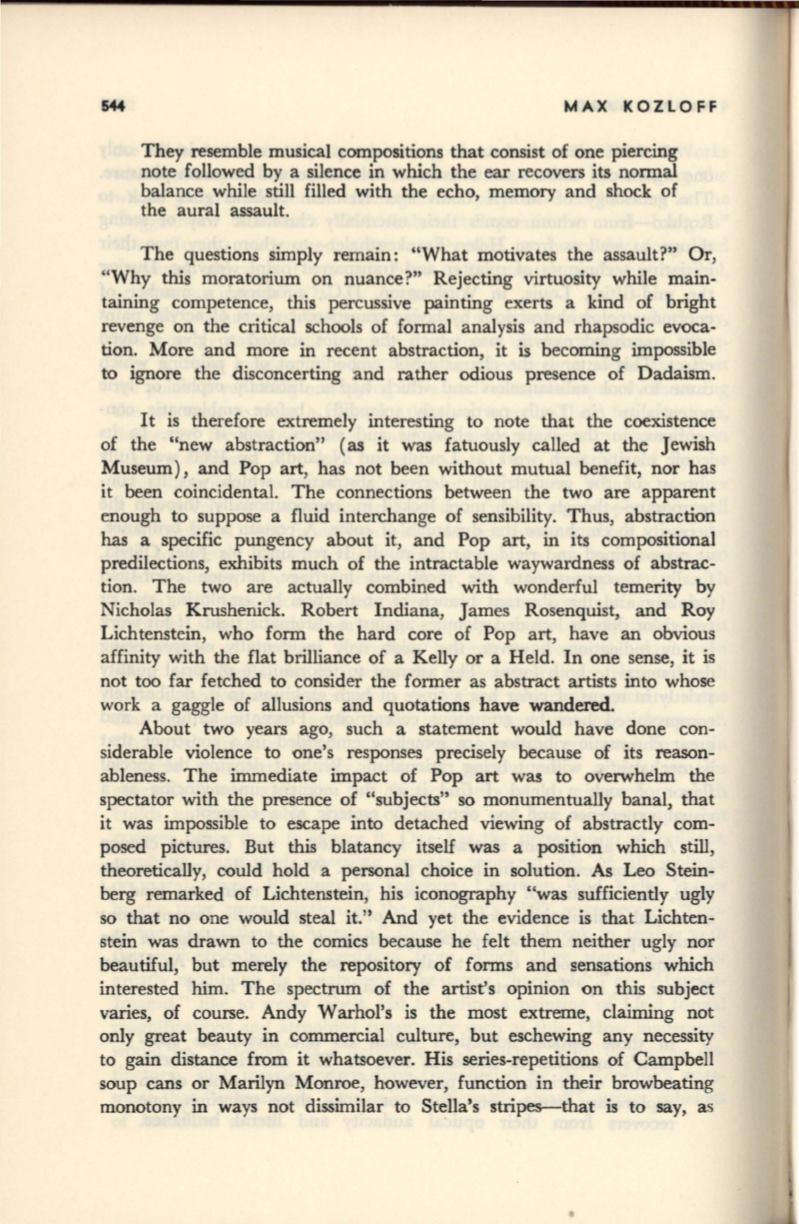

MAX KOZLOFF
They resemble musical compositions that consist of one piercing
note followed by a silence in which the ear recovers its normal
balance while still filled with the echo, memory and shock of
the aural assault.
The questions simply remain: "What motivates the assault?" Or,
"Why this moratorium on nuance?" Rejecting virtuosity while main–
taining competence, this percussive painting exerts a kind of bright
revenge on the critical schools of formal analysis and rhapsodic evoca–
tion. More and more in recent abstraction, it is becoming impossible
to ignore the disconcerting and rather odious presence of Dadaism.
It is therefore extremely interesting to note that the coexistence
of the "new abstraction" (as it was fatuously called at the Jewish
Museum), and Pop art, has not been without mutual benefit, nor has
it been coincidental. The connections between the two are apparent
enough to suppose a fluid interchange of sensibility. Thus, abstraction
has a specific pungency about it, and Pop art, in its compositional
predilections, exhibits much of the intractable waywardness of abstrac–
tion. The two are actually combined with wonderful temerity by
Nicholas Krushenick. Robert Indiana, James Rosenquist, and Roy
Lichtenstein, who form the hard core of Pop art, have an obvious
affinity with the flat brilliance of a Kelly or a Held. In one sense, it is
not too far fetched to consider the former as abstract artists into whose
work a gaggle of allusions and quotations have wandered.
About two years ago, such a statement would have done con–
siderable violence to one's responses precisely because of its reason–
ableness. The immediate impact of Pop art was to overwhelm the
spectator with the presence of "subjects" so monumentually banal, that
it was impossible to escape into detached viewing of abstractly com–
posed pictures. But this blatancy itself was a position which still,
theoretically, could hold a personal choice in solution. As Leo Stein–
berg remarked of Lichtenstein, his iconography "was sufficiently ugly
so that no one would steal it." And yet the evidence is that Lichten–
stein was drawn to the comics because he felt them neither ugly nor
beautiful, but merely the repository of forms and sensations which
interested him. The spectrum of the artist's opinion on this subject
varies, of course. Andy Warhol's is the most extreme, claiming not
only great beauty in commercial culture, but eschewing any necessity
to gain distance from it whatsoever. His series-repetitions of Campbell
soup cans or Marilyn Monroe, however, function in their browbeating
monotony in ways not dissimilar to Stella's stripes.-that is to say, as









